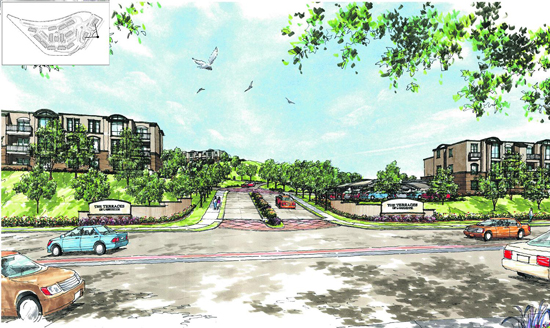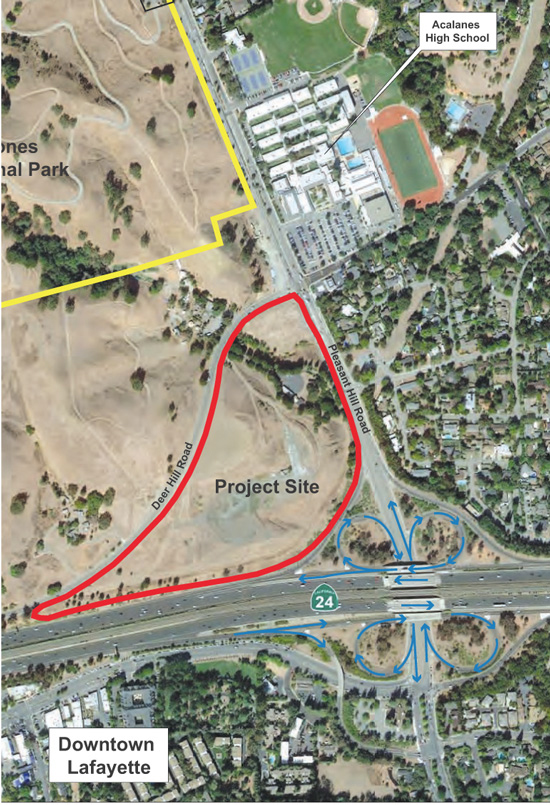 | | | View of main entry on Pleasant Hill Road Image provided
| | | | | | Confucius allegedly said the journey of a thousand miles begins with a single step. After going through a lengthy, expensive process to produce an environmental impact report, which was recently certified, the Terraces of Lafayette project commenced winding its way through the city's review process that includes the Circulation Commission, Design Review Commission, Parks, Trails and Recreation Commission and finally the Planning Commission.
 Transportation issues surrounding the project and dealing with impacts on the existing bottleneck that is the Pleasant Hill Road and Deer Hill Road intersection is the circulation commission's task. As the developer O'Brien Land Company's architect and traffic engineer made their case, audible chuckles and murmurs could be heard throughout the auditorium.
Transportation issues surrounding the project and dealing with impacts on the existing bottleneck that is the Pleasant Hill Road and Deer Hill Road intersection is the circulation commission's task. As the developer O'Brien Land Company's architect and traffic engineer made their case, audible chuckles and murmurs could be heard throughout the auditorium.
 It's no secret that the proposed 315 unit multi-family project is not popular with residents. Indeed a parade of citizens came forward at this first meeting to testify about the negative impacts of the 14 apartment buildings, which if approved would dot the hillside near Acalanes High School.
It's no secret that the proposed 315 unit multi-family project is not popular with residents. Indeed a parade of citizens came forward at this first meeting to testify about the negative impacts of the 14 apartment buildings, which if approved would dot the hillside near Acalanes High School.
 One of the key concerns is the significant and unavoidable impacts due to increased traffic on Pleasant Hill Road. News to many residents is the Lamorinda Action Plan that assesses regional transportation issues within Lamorinda and has policies and objectives - one crucial aspect, especially with regard to this development, is the gateway constraint policy. Required by Measure J, it identifies and limits the number of vehicle lanes for arterial roads.
One of the key concerns is the significant and unavoidable impacts due to increased traffic on Pleasant Hill Road. News to many residents is the Lamorinda Action Plan that assesses regional transportation issues within Lamorinda and has policies and objectives - one crucial aspect, especially with regard to this development, is the gateway constraint policy. Required by Measure J, it identifies and limits the number of vehicle lanes for arterial roads.
 Senior Planner Greg Wolff pointed out at the end of the very long meeting that the applicant (O'Brien) has stated that the city is using stop signal timing to implement the gateway constraint policy. He wanted to make it clear that according to the city engineer, "that is not the case."
Senior Planner Greg Wolff pointed out at the end of the very long meeting that the applicant (O'Brien) has stated that the city is using stop signal timing to implement the gateway constraint policy. He wanted to make it clear that according to the city engineer, "that is not the case."
 Developers of the Terraces project have proposed adding a lane to ease congestion on a portion of Pleasant Hill Road. In addition, they proposed several transportation related improvements: a dedicated place to drop off students, improved sidewalks, and installing a class II bike lane that buffers cyclists with a strip of landscaping between them and motorists zipping by.
Developers of the Terraces project have proposed adding a lane to ease congestion on a portion of Pleasant Hill Road. In addition, they proposed several transportation related improvements: a dedicated place to drop off students, improved sidewalks, and installing a class II bike lane that buffers cyclists with a strip of landscaping between them and motorists zipping by.
 The city concluded that traffic is a significant impact that is difficult to mitigate, said Steve Abrams of Abrams Associates Traffic Engineering, "but this additional travel lane provides additional capacity and improves traffic flow." He concluded that the lane would be enough to mitigate the traffic impacts of this project.
The city concluded that traffic is a significant impact that is difficult to mitigate, said Steve Abrams of Abrams Associates Traffic Engineering, "but this additional travel lane provides additional capacity and improves traffic flow." He concluded that the lane would be enough to mitigate the traffic impacts of this project.
 "This project spoils the site," said the first of many public speakers. "It's the wrong development at the wrong location." Other speakers spoke of pedestrian safety, children's access to play areas and much more.
"This project spoils the site," said the first of many public speakers. "It's the wrong development at the wrong location." Other speakers spoke of pedestrian safety, children's access to play areas and much more.
 Attorney Allan Moore wrapped up the meeting with a rebuttal on a conciliatory note, "We want to work with you," and explained that not everyone can afford a single-family home in Lafayette, adding that this parcel of land has been designated for high density housing for 50 years.
Attorney Allan Moore wrapped up the meeting with a rebuttal on a conciliatory note, "We want to work with you," and explained that not everyone can afford a single-family home in Lafayette, adding that this parcel of land has been designated for high density housing for 50 years.
 City staff found that neither the current plan, nor its smaller revised version called the Mitigated Project Alternative (MPA) "complies with many of the goals, policies and programs in the General Plan," so they can't recommend the project or the MPA as proposed. The staff report points out the developer could submit a revised project that would "meaningfully address the issues in the staff analysis" and reduce significant impacts to zero or near zero. The circulation commission left city staff with some questions to be answered at their next get together slated for Oct. 21 at the Lafayette Community Center's Manzanita Room.
City staff found that neither the current plan, nor its smaller revised version called the Mitigated Project Alternative (MPA) "complies with many of the goals, policies and programs in the General Plan," so they can't recommend the project or the MPA as proposed. The staff report points out the developer could submit a revised project that would "meaningfully address the issues in the staff analysis" and reduce significant impacts to zero or near zero. The circulation commission left city staff with some questions to be answered at their next get together slated for Oct. 21 at the Lafayette Community Center's Manzanita Room.

|

